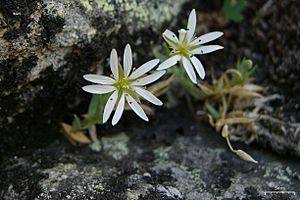Longstalk starwort facts for kids
Quick facts for kids Longstalk starwort |
|
|---|---|
 |
|
| Scientific classification | |
| Genus: |
Stellaria
|
| Species: |
longipes
|
Stellaria longipes, also known as longstalk starwort or Goldie's starwort, is a type of flowering plant. It belongs to the Caryophyllaceae family, which includes many kinds of pinks and carnations. This plant grows all around the northern parts of the world, like a circle around the Arctic Circle.
About Longstalk Starwort
This plant is very adaptable. It can grow in many different places. You can find it in cold, treeless tundra areas. It also grows in taiga forests, which are mostly made of pine trees. Further south, it thrives in subalpine and alpine climates. These are high mountain areas with cool temperatures.
What It Looks Like
Stellaria longipes can look very different depending on where it grows. Its shape changes based on its genes and the environment. It also has a varying number of chromosomes.
Generally, it is a rhizomatous perennial herb. This means it's a plant that lives for many years. It spreads using underground stems called rhizomes. It can form dense mats or clumps. Sometimes, it grows straight up. Its stems can be short and simple. Other times, they are long and branch out a lot.
The leaves are usually 1 to 4 centimeters long. They are shaped like lines or narrow spearheads. They grow in pairs, directly opposite each other on the stem.
Flowers and Reproduction
The plant produces one or more flowers. Each flower grows on a short stalk called a pedicel. The group of flowers is called an inflorescence.
Each flower has five pointed green parts called sepals. These are usually a few millimeters long. There are also five white petals. Each petal is split into two lobes. Sometimes the split is shallow. But often, it's so deep that it looks like there are ten petals instead of five!
This plant is gynodioecious. This means some flowers have both male and female parts that work. Other flowers only have female parts.
Special Subspecies
There are two main types, or subspecies, of Stellaria longipes. One of them is quite rare. It's called subsp. arenicola. This special type only grows in the sand dunes near Lake Athabasca. This lake is located in central Canada.

